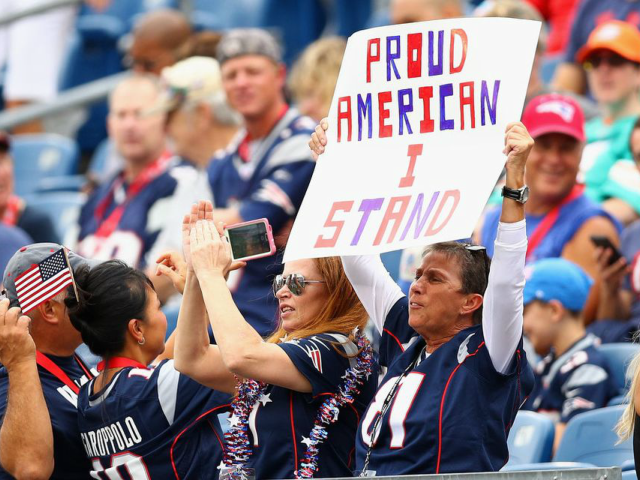The NFL’s TV ratings slide seems to have stabilized this season, and in some cases even seen gains. Moreover, the good ratings news coincides with dwindling player protests during the national anthem.
TV executives and liberal commentators are celebrating the NFL’s stabilized ratings after two straight years of losing viewers. Some have also noted that the small growth in viewership comes after the protests during the national anthem dwindled to but a handful of players — and generally the same 5 or 6 players every week.
While there are other reasons — such as the explosion in offensive output — for why NFL ratings are rebounding. It’s impossible not to note that the league’s ratings plummeted when the protests began, and came back after the protests all but went away.
According to Pro Football Talk, the NFL’s TV ratings have edged up a three percent in viewers. But that is remarkable considering that since 2015 ratings have been falling sometimes by as much as double digits. So, even a relatively small three percent rise is notable.
Indeed, the NFL’s TV numbers have stopped the slide and seen some small improvement even as the rest of TV continues to see fewer viewers.
“Everything in television is threatened in ratings because people have so many other choices, and that includes the NFL,” pop culture professor Robert Thompson told NBC News. “But in the end, I think the NFL is actually surprisingly stable given all of those other changes.”
The ratings slide continued in the first few weeks of the 2018 season, but since then the overall numbers are slightly up. And as numbers are up, anthem protests are down. Where sometimes up to 20 players and more took a knee or raised a militant fist during the nation’s song last season, this year only a few die-hard protesters continue to demonstrate.
Some commentators and industry analysts actually have noted that the low number of anthem protests have had an impact on ratings.
John Ourand and Austin Karp of the SportsBusiness Journal, for instance, cited “far fewer player protests” as one of a list of reasons that the NFL has seen a halt to its ratings slide.
Mike Mulvihill, Fox Sports executive vice president of research, also recently noted that the anthem problem is now “largely resolved.”
“It’s largely a resolved issue,” Mulvihill said of the anthem protests. “That’s one of the reasons we are seeing stabilization in the numbers. There’s not a lot of new information there for fans to digest. Everyone has reached their own conclusion on it.”
Mark Lazarus, chairman of NBC Broadcasting and Sports, also noted that the protests had lost their power on all sides of the issue.
“People who decided that they were going to leave left,” Lazarus said. “But I also think that some of those people maybe felt like they made their point and now their love of football is overriding it, and they are coming back.”
The league and owners should still take heed. Sean McManus of CBS also noted that fans are exhausted with politics in sports.
“One of the things that our research has showed is that when people are watching football games, in a perfect world they view it as an escape,” McManus added. “They want to get away from the politics and the other storylines that are dominating the media landscape.”
With the number of players still protesting at a new low of only about six players, people may feel less like liberal politics is being forced onto their football escape and are therefore coming back to the game. And while not many commentators or executives want to put too much emphasis on the dwindling protests as a factor, the league should not discount that the end of protesting has contributed to the ratings rise.
Finally, there is one thing the NFL should be worried about concerning the fanbase. As Pro Football Talk pointed out, the league’s audience is skewing older and the game is not attracting new, young fans to replace their elders. That is not a good trend for the long term.
Follow Warner Todd Huston on Twitter @warnerthuston.

COMMENTS
Please let us know if you're having issues with commenting.